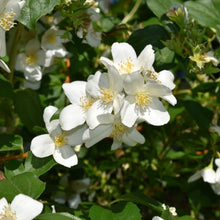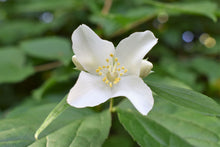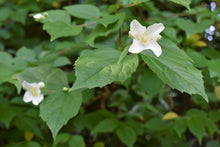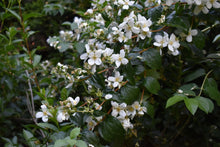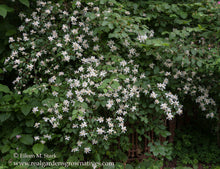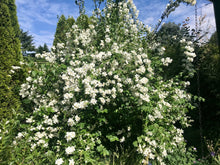
Philadelphus lewisii
Mock orange is an extremely versatile shrub best known for its sweetly fragrant white blossoms which appear in abundance from late spring through early summer, filling the air with the scent of orange blossoms. It thrives in a wide variety of habitats and garden conditions and is an excellent plant for erosion control, screens and habitat hedgerows. Mock orange also has a plethora of habitat values, including attracting bees, butterflies and other insect pollinators to your fruit and vegetable garden.
- Plant type/canopy layer: deciduous, perennial, large shrub
- Size at maturity: 6-14' tall, 4-10' wide
- Light requirements: full sun, part sun/part shade, full shade
- Moisture requirements: dry to moist soil, preferably well-drained
- Bloom time: May - July
- Growth rate/ease: fast growth rate, easy to grow
- Native habitat/range: grows in a variety of habitats including moist open woodlands, conifer forests, dry rocky hillsides and canyons, and sagebrush deserts at low to mid-elevations throughout western North America from southern B.C. to northern California and the Sierras, and east to Alberta and western Montana. Portland Plant List - yes.
- Wildlife support: flowers attract and provide nectar for nocturnal moths, adult butterflies such as the tiger swallowtail, bees, syrphid flies, and other insect pollinators; seeds are attractive to many species of birds and small mammals, particularly quail and squirrels; branches and twigs are quality browsing fuel for deer and elk, and provide cover year round for birds and small mammals; overall plant attracts and supports beneficial and pest-eating insects and is a caterpillar host plant and larval food source for native moths and butterflies
- Special features: landscape uses include soil stabilization, erosion control, screen and hedgerow; ethnobotanical uses, particularly for native people, include the wood can be made into tools, snowshoes, combs, arrow & harpoon shafts, netting shuttles, cradle hoops, digging sticks and more recently knitting needles and tobacco pipes, leaves and bark, which contain saponins, can be mixed in water for use as a mild soap to wash hands, body and hair
Gardening with Mock Orange: Mock orange grows quickly, easily and is relatively low-maintenance once established. Be sure to give this lovely yet large shrub plenty of space, in a special place where the scent of its fragrant flowers will be adored. It’s drought-tolerant, thriving in soils that are moist to dry and well-draining. It does best and flowers prolifically in full-to-part sun but can withstand a fair amount of shade - but will produce less blooms, with less sun. Its fibrous root system makes it excellent at stabilizing soils and it makes an excellent hedge or screen.
It is ideal to allow any plant, including mock orange, to achieve its natural size and form - but pruning is an option, especially considering mock orange's less-than-compact habit. Be sure to prune after flowering, since next year’s blossoms develop on the previous year’s new growth. Cut out up to 20 percent of old stems from the base, leaving the younger, more vigorous shoots to produce a spectacular floral display next year. In the garden, consider planting it with some of its natural associates; Douglas-fir, oceanspray, ninebark, osoberry, baldhip rose, and tall Oregon grape, and others.
Photo Credits 1-6, 8: Nikkie West, Sparrowhawk Native Plants
Photo Credit 7: Eileen Stark








